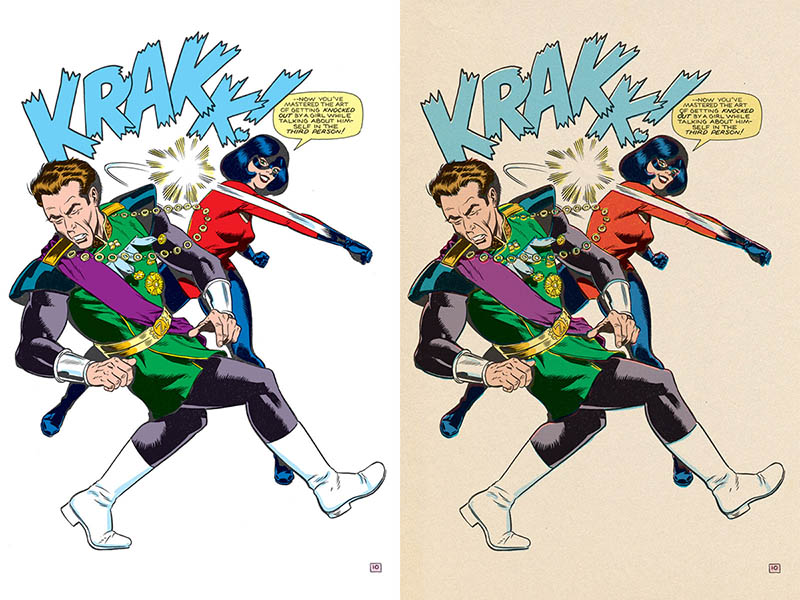Without the dots, ink gain and absorbent newsprint, the colors are louder than intended. This was discovered during the economic and technological shift of the 1980s, when publishers actually printed 64 colors on nicer paper. That's when the industry went with full digital color, effectively ending the four color process era of comics.
Sadly, Marvel and DC republish their pre-digital comics just like this. For more on how the physical material is just as important as the intellectual property and artist intent, check out John Hilgart's excellent article In Defense of Dots: The lost art of comic books.
Michael Gagne's restoration process for the Simon & Kirby romance comics (order from publisher) is also informative.
In short, "Enter...General Zaq!" wouldn't be the best action-packed contrast of old and new comics art without emulating Silver Age four color process techniques to the best of my abilities. Thanks for lighting the fire, John & Mike!
Phase One: Ben Day Dots and Screen Angles
Based on the John Roshell technique (see below), which is much better than Photoshop's Color Halftone filter. To begin:
- Color your art in CMYK (Save the original)
- Click the Cyan channel, SELECT ALL, COPY. Create NEW DOCUMENT, then PASTE. This is a temporary file for creating this effect.
- Convert the new file to Bitmap (under the MODE menu), with method "Halftone Screen" set to Round. Frequency determines how coarse the dots are. I normally use 65 dpi for 400 ppi art. Screen angles to avoid the moiré effect:
- CYAN 105 degrees
- MAGENTA 75 degrees
- YELLOW 90 degrees
- BLACK 45 degrees
- SELECT ALL, COPY.
- PASTE into the Cyan channel of your art (on a Layer with some flat color). Repeat process for YELLOW & MAGENTA.
Phase Two: Color and Texture
Adopting only two steps of the Les McClaine method (see below), since I prefer John Roshell's channel manipulation over McClaine's reliance on Photoshop's Color Halftone filter.
- Paste high-contrast grayscale newsprint texture into each CMYK layer in Quickmask mode.
- While the layer is still selected, adjust in Edit/Fade Fill, Edit/Transform/Rotate, etc.
To get a CMYK layer look off-register, select its channel and move it slightly out of alignment with the arrow key.
Source Material
- Theory and examples
- "In Defense of Dots: The lost art of comic books" by John Hilgart.
- Michel Gagne's restoration of Simon/Kirby romance comics Single-handedly restored Simon & Kirby romance comics as a labor of love.
- Photoshop techniques
- "Giving Artwork the 'Comic Book Look'" by John Roshell for Comicraft. More time-consuming than Photoshop's "Color Halftone" filter, but much better results. This technique uses CMYK channels, creating custom dot and rotation control with temporary grayscale to bitmap conversion.
- "How To Color Like A Little Old Lady" by Les McClaine. Taking the John Roshell technique up a notch, adding texture and fade controls per channel.
Dave Marshall
